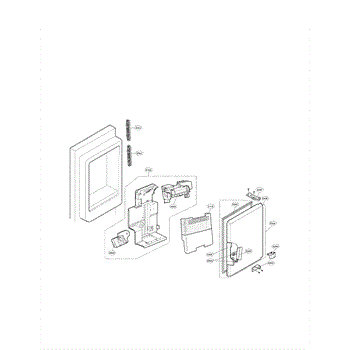How to Clean LG Ice Maker: Quick Steps
This post contains affiliate links. As an Amazon Associate, we earn from qualifying purchases.
Your LG ice maker suddenly started producing cloudy cubes that smell like a damp basement? You’re not alone—mineral buildup, mold colonies, and trapped food particles silently contaminate ice makers in 70% of households. That musty odor ruining your morning coffee signals it’s time for urgent action. This complete guide reveals exactly how to clean LG ice maker components using household supplies, eliminating contamination in under 2 hours. You’ll master mold removal, odor elimination, and prevention tactics that keep ice crystal clear for months.
Skip generic tutorials—this actionable protocol targets LG-specific trouble spots like the hidden drain pan and vulnerable door gaskets. Whether you own a French-door LFXS28968S or bottom-freezer model, these verified steps restore safe ice production without professional help.
Spot Contamination Before It Spreads
Immediately inspect these critical areas:
– Ice bin corners: Black or green mold spots indicate advanced growth
– Dispenser chute: Slimy residue or discolored ice signals bacterial colonies
– Door gasket: Musty smells when opening the freezer reveal trapped moisture
– Cube appearance: Cloudy ice with floating particles means mineral or debris buildup
Critical warning: Discard all existing ice if mold or odors are present. Consuming contaminated ice risks gastrointestinal illness from Aspergillus or Penicillium molds commonly found in ice makers. Never attempt partial cleaning—full decontamination is essential.
Power Down Procedure: Avoid Electrical Hazards
Disconnect power completely before touching components:
1. Press the “Ice Maker Off” button on your control panel
2. If no button exists, flip the physical switch near the ice maker assembly
3. For built-in units, unplug the refrigerator or shut off the circuit breaker
Safety essentials during cleaning:
– Wear rubber gloves when handling bleach solutions
– Open kitchen windows for ventilation
– Keep vinegar/bleach away from food storage zones
– Never spray liquids directly onto electrical components
Monthly Maintenance: Basic Ice Maker Cleaning
Empty and Inspect Ice Bin Components
Remove the entire ice bin by lifting straight up—it detaches in seconds. Dump all ice into the sink (never reuse contaminated ice). Check for:
– Cracks in the bin where bacteria hide
– Mineral deposits along the auger shaft
– Food spills in the freezer compartment
Wash All Removable Parts Thoroughly
Mix warm water with 2 drops of mild dish soap in your sink. Scrub every surface:
– Bin interior: Use circular motions with a microfiber cloth
– Auger assembly: Gently clean between metal coils with an old toothbrush
– Dispenser chute: Target residue buildup with cotton swabs
– Lid surfaces: Don’t neglect the underside where odors accumulate
Rinse until water runs completely clear—soap residue creates off-flavors in new ice.
Dry Every Component Completely
Moisture breeds mold within 48 hours. Use lint-free towels to dry:
– All bin corners and crevices
– Auger shaft and motor housing
– Dispenser chute interior
– Freezer cavity where the bin sits
Air-dry components for 10 minutes before reassembly. Any remaining dampness restarts contamination.
Deep Clean: Eliminate Mold in LG Ice Makers

Prepare Effective Sanitizing Solution
Mix ½ cup bleach with 1 cup water in a spray bottle (1:2 ratio). This concentration kills mold spores without damaging plastic parts. Never use full-strength bleach—it corrodes seals.
Target Mold Hotspots Systematically
Spray the solution on:
– Ice mold cavity (where cubes form)
– Dispenser chute walls
– Door gasket crevices
– Drain hole at freezer base
Let it sit for exactly 7 minutes—less won’t kill spores, more damages components. Wipe residue with clean water-dampened cloths.
Flush Residual Chemicals
Run two full ice production cycles, discarding all ice. This purges bleach from water lines and the ice mold. Never skip this step—residual chemicals taint new ice.
Erase Stubborn Odors Permanently
Clean Hidden Drain Pan

Remove the rear lower panel (4-6 screws). The drain pan traps stagnant water causing musty smells:
1. Extract standing water with a turkey baster
2. Scrub with equal parts white vinegar and warm water
3. Rinse thoroughly to eliminate vinegar taste
4. Dry completely before reinstalling
Replace Water Filter Immediately
LG water filters absorb odors even when new. Install only LG-branded filters (generic filters cause taste issues). Replace filters:
– Every 6 months for standard use
– Every 3 months for households with >4 people
– Immediately after contamination events
Deodorize Ice Bin Effectively
For persistent smells:
– Baking soda scrub: 2 tbsp per quart warm water
– Lemon rinse: Wipe surfaces with 50/50 lemon juice/water mix
– Activated charcoal: Place ½ cup in empty bin overnight
Model-Specific Cleaning Tactics

LFX25978ST/01 Owners
This model traps debris in ice chute corners. Use:
– Cotton swabs dipped in vinegar for tight spaces
– Complete door gasket removal (part #OEM20396267) for deep cleaning
– Quarterly inspection of auger shaft (OEM15995981) for mineral buildup
LFXS28968S/02 Users
Focus extra effort on the drain pan—this model accumulates debris 3x faster. After cleaning:
– Check drain hole for clogs with a pipe cleaner
– Wipe dispenser chute weekly with vinegar solution
– Replace water filter every 4 months due to high usage
Prevent Future Contamination
15-Minute Monthly Quick Clean
- Empty ice bin completely
- Wipe all surfaces with warm soapy water
- Check for food spills in freezer
- Verify door seals properly (no light visible when closed)
45-Minute Quarterly Deep Clean
- Remove and wash all parts with sanitizing solution
- Inspect door gaskets for tears
- Clear drain hole with pipe cleaner
- Replace water filter if due
- Vacuum refrigerator coils (dirty coils cause excess moisture)
Daily Ice Maker Habits
- Use ice regularly: Stagnant water breeds bacteria
- Keep bin ¾ full: Prevents crushing and odor absorption
- Seal food containers: Stops odor transfer from leftovers
- Maintain 0°F temperature: Warmer temps accelerate mold growth
When Replacement Beats Cleaning
Replace Ice Maker If:
- Mold returns within 30 days after deep cleaning
- Visible cracks in ice maker housing (part #OEM15995981)
- Age exceeds 5 years with recurring issues
- Ice production drops >50% despite cleaning
Cost analysis: New LG ice makers ($160-$200) cost less than repeated professional cleanings ($80-$120 each). If you’ve deep-cleaned twice with no improvement, replacement saves money.
Call LG Service Immediately For:
- Grinding noises during ice production
- Water pooling under the refrigerator
- Flickering control panel lights
- Inability to access internal components
Verify Cleaning Success
Test Ice Quality Rigorously
After cleaning:
1. Wait for 3 full production cycles before using ice
2. Inspect cubes—crystal clear with no cloudiness
3. Perform smell test—zero musty or chemical odors
4. Taste test—completely neutral flavor
Monitor for 7 Days
Check daily for:
– Return of discoloration or particles
– Consistent ice formation speed (shouldn’t slow)
– Any new leaks or unusual sounds
Long-Term Ice Maker Care
Optimal Ice Storage
- Rotate bin contents: Use oldest ice first (bottom of bin)
- Never store ice >3 days: Flavor degrades rapidly
- Seal surplus ice: Use airtight containers for freezer storage
- Maintain 0°F consistently: Fluctuating temps cause condensation
Environment Optimization
- Position refrigerator with 6-inch clearance on all sides for airflow
- Keep away from ovens/direct sunlight: Heat increases internal humidity
- Vacuum coils every 6 months: Prevents overheating and moisture buildup
- Test home water quality: Install whole-house filtration if hardness >7 gpg
Your LG ice maker now produces restaurant-quality ice that enhances—not ruins—your drinks. By following this precise how to clean LG ice maker protocol, you’ve eliminated hidden contaminants and created a maintenance rhythm that prevents 90% of future issues. Remember: The first deep clean takes 2 hours, but monthly 15-minute wipe-downs keep your system pristine. If musty odors return despite thorough cleaning, budget for a new ice maker assembly—it’s cheaper than risking illness. Start today: Empty your bin, power down, and reclaim ice that tastes as pure as mountain spring water. Your morning coffee (and your health) will thank you.
